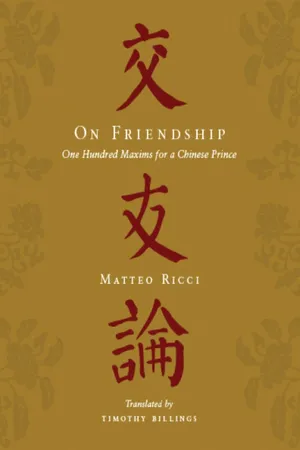
- English
- ePUB (mobile friendly)
- Available on iOS & Android
About This Book
" On Friendship, with its total of one hundred sayings, is the perfect gift for friends."—Feng Yingjing, renowned scholar and civic official, 1601
Matteo Ricci (1552-1610) is best known as the Italian Jesuit missionary who brought Christianity to China. He also published a landmark text on friendship—the first book to be written in Chinese by a European—that instantly became a late Ming best seller.
On Friendship distilled the best ideas on friendship from Renaissance Latin texts into one hundred pure and provocative Chinese maxims. Written in a masterful classical style, Ricci's sayings established his reputation as a great sage and the sentiments still ring true.
Available for the first time in English, On Friendship matches a carefully edited Chinese text with a facing-page English translation and includes notes on sources and biographical, historical, and cultural information. Still admired in China for its sophistication and inspirational wisdom, On Friendship is a delightful cross-cultural work by a crucial and fascinating historical figure. It is also an excellent tool for learning Chinese, pairing a superb model of the classical language with an accessible and accurate translation.
Frequently asked questions
Information

















Table of contents
- Cover
- Half title
- Title
- Copyright
- Dedication
- Contents
- Acknowledgments
- Introduction
- On Friendship
- Chronology of Editions
- Texts and Variants
- Sources and Notes
- Index